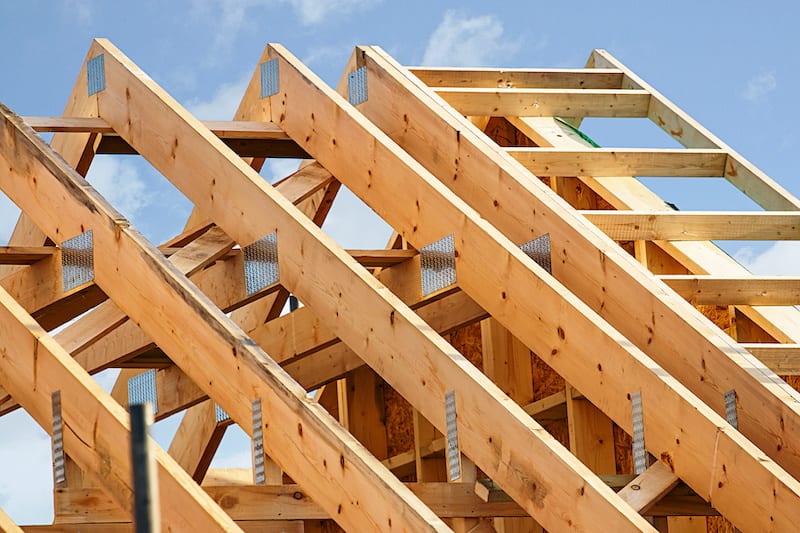Cut Attic Trusses 101
Cut or damaged attic trusses can be a major problem in a home. Yet most people don’t even know what that means, much less why it is such a major issue.
The most important thing you need to know is that they definitely can be repaired. But it will require the help of a structural engineer.
Here’s everything you need to know about cut or damaged trusses, and why you should pay attention to them in a home.
What are Trusses?
By definition, a truss “consists of two-force members only, where the members are organized so that the assemblage as a whole behaves as a single object.”
But that may be a bit much.
In lay terms, it’s the wooden triangles that you see exposed when you go into your home’s attic. They hold up your roof and sometimes keep your walls together.
Trusses are found everywhere if you look closely. From bridges and large electrical transmission poles to automotive frames and even Geodesic domes, we can literally find them all over the place.
They are designed to carry loads (both “dead” and “live” loads). But this article is specific to their use in the attics of homes. More precisely, the common types made of lumber that are found in most homes today.
To begin, you should know that attic trusses are designed specifically for your home by an engineer. Not all homes have trusses. So it’s important to distinguish the difference between an engineered truss and conventional (i.e. “stick”) framing.
History of Attic Trusses
Historically, roof and floor structures were built by tradespersons on-site and by hand. This is also known as conventional or “stick” framing. Some of the common components in them are rafters, joists, ridges, ties, and strongbacks.
While this method is still done plenty today, advancements in technology over the decades have allowed for this framing to be done in a factory-controlled environment. This allows for higher consistency, accuracy, speed, fewer/lighter materials, and cost savings.
However, in order to adequately handle the heavy loads, the design calculations of trusses are very specific. This is why they are designed by a structural engineer and are also commonly known as “engineered trusses.”
Some common components of engineered trusses are beams (known as chords), webs, and gusset plates (nodes). There are many factors that go into designing these trusses, such as:
- Considerations of tension (tensile), and
- Compression strengths, spans, and triangulation
Why are Cut or Damaged Attic Trusses a Problem?
Whenever attic trusses have been cut or damaged, it jeopardizes the home’s structural integrity. Homeowners or maintenance workers sometimes cut truss members to create more headspace to move items in or out of an attic. Alternately, the low horizontal beam (chord) of a truss may be cut in the middle. This is done so a section can be taken out of it to create a clearer entry hatch into the attic. But this also means that the central gravity of a home’s roof structure is compromised.
This is a bad idea.
Many homes in Florida have the HVAC Air Handler installed in the attic. This isn’t the best practice, but it’s quite common.
During our inspections, we have seen too often where an AC installer has simply cut out and removed members of a truss (or three) to gain more access and workspace. Sometimes they may attempt to “repair” or brace the area. However, they aren’t structural engineers, so the work is almost always inadequate.
What To Do About Cut Trusses as a Buyer or Homeowner
If you move into a home that has cut or damaged tresses, don’t panic! The damage can be repaired.
First, don’t do the work yourself. You can’t simply scab or “sister” over the damaged wood and call it good. DIY fixes by novice homeowners or even skilled carpenters are almost always incomplete or incorrect and can result in more damage than before.
Repairing Attic Trusses
To repair the trusses, a structural engineer should always be consulted because (remember) these are specifically engineered components for your home. No one else is qualified to evaluate the issue or to prescribe a repair. The engineer will evaluate the damaged area and prepare specified design drawings for conducting a proper repair. After you get these drawings, repairs can be performed in accordance with the drawings by a qualified contractor of your choice. Then the engineer will sign off on the work if all is correct after they inspect it. Usually, a copy of these repair drawings will be stapled to the area in question for future reference (like when you sell your home and the home inspector sees the repairs, wink wink).
If you have a cut or damaged truss in your attic, don’t feel like it’s something that can’t be handled. Sure it’s a big enough deal that it needs to be addressed, but don’t let it derail you. Many have been down this road before. Your agent or home inspector may be able to help provide you with some quality contacts to get started. The cost and time to repair cut trusses in your attic are minimal compared to the damage that can result in leaving it unrepaired or passing on a home you otherwise loved.
REFERENCES: (1) Plesha, Michael E.; Gray, Gary L.; Costanzo, Francesco (2013). Engineering Mechanics: Statics (2nd ed.). New York: McGraw-Hill Companies Inc. pp. 364–407.






